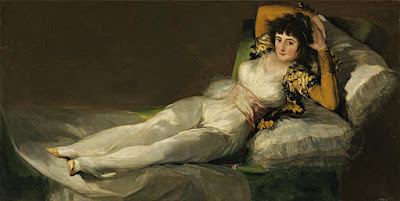GOYA * tba
BOOK LAUNCH
10 Reasons Why Studying Art History in Spain Offers a Rich and Captivating Experience by Karla Darocas, Arts Historian
I have been researching, writing and teaching about Spanish art for over 30 years. I have found that studying art history in Spain offers a unique opportunity to explore a vibrant artistic landscape that spans centuries, cultures and movements. It is an enriching journey that broadens artistic horizons, and deepens understanding and appreciation of the fascinating world of art.
Here are 10 reasons why I love Spain and its artistic heritage!
Sculptures by the Andalusian Baroque Master Pedro de Mena in Gandía
One of my favourite treasure chests is the Santa Clara Museum in Gandia. Its roots go back to 1431, when Violante de Aragón, daughter of Alfonso de Aragón - senor, Duke of Gandia, founded the convent of Santa Clara in this town.
Since its foundation, many famous women have sought the spiritual refuge of the convent, either because of a sincere vocation or because they were forced to do so by their families who were unable to provide a suitable marriage.
* Report by art historian and educator , Karla Darocas, Hons. B.A. (KarlaDarocas.com)
MAJA WITH A SMALL DOG, 1865, Eugenio Lucas Velázquez
WHAT IS ANDALUSIAN ROMANTICISM?
Seville, a city in the Andalusia region of southern Spain, played an important role in the development of Romanticism in Spain during the 19th century. Among the most important painters of this movement from Seville are:
Manuel Barrón y Carrillo - Born in Seville in 1814, Barrón y Carrillo was a painter who specialised in landscapes and genre scenes. His work was characterised by a very detailed style and focused on the colours and textures of the Andalusian landscape.
Joaquín Domínguez Bécquer - Born in Seville in 1822, Bécquer was a painter and illustrator who was also the brother of the famous Romantic poet Gustavo Adolfo Bécquer. His work was characterised by a very detailed style and focused on the emotions and expressions of his subjects.
José Jiménez Aranda - Born in Seville in 1837, Aranda was a prolific painter who specialised in historical and genre scenes. His work was characterised by a concentration on everyday life and a romanticising view of Andalusian culture and traditions.
Overall, these painters played an important role in the development of Romanticism in 19th century Spain, and their works are still celebrated and admired today.
Andalusian Romanticism also had an important influence on Spanish music, particularly the flamenco tradition. During this period, flamenco music began to evolve from a local Andalusian style into a national symbol of Spanish identity and became increasingly popular with artists and intellectuals throughout the country, but that's another story!
Overall, Andalusian Romanticism represented a celebration of Andalusian culture and traditions, as well as a reaction to the industrialisation and modernisation that swept Spain in the 19th century. It played an important role in the development of Spanish art, literature and music, and continues to inspire and influence artists today.
PORT OF MÁLAGA by Manuel Barrón y Carrillo
VIDEO - End of the Day, Joaquin Sorolla, 1900
*******APPRECIATE ART & CULTURE * LOVE SPAIN
Resource Books written by
Karla Ingleton Darocas
and published by
SpainLifestyle.com
Resource Books written by
Karla Ingleton Darocas
and published by
SpainLifestyle.com
* CLICK HERE *
*******
-
📬 Join Now & Get Updates, FREE Educational Arts Articles and Lecture Invites Directly to Your Inbox ! * emails never shared or sold!...
-
THE ENIGMA Dionisio Fierros (1827-1894) was a Spanish Romantic painter who painted a “Vanitas”, an allegorical still life, for the Marquis ...
-
One of the most enduring and frequently depicted themes in the history of art—especially in the Western tradition—is the image of the moth...

















